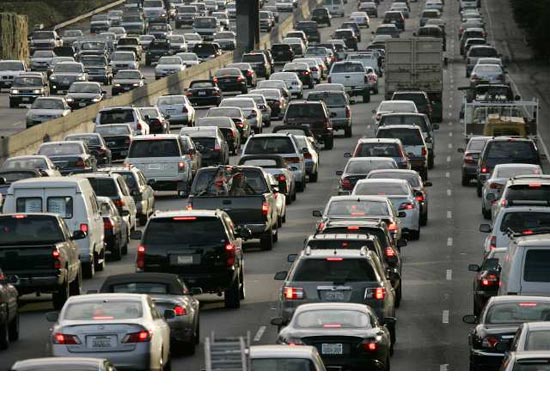Westside story—always a traffic drama
October 9, 2011
It’s official: Rush hour on the Westside is nasty, brutish and long.
A new report assessing potential routes for the Westside subway extension looks at current traffic conditions in the area to project what the future would likely bring, with or without a subway.
In doing so, it quantifies some of the modern-day commuter horror stories that have become the stuff of local—and international—legend.
The report offers a snapshot of a deeply dysfunctional network of freeways and surface streets in which rush hour traffic moves at less than 10 miles per hour. A major incident can bring the entire area to a standstill. (Remember President Obama’s motorcade last month?) Rush hour starts at 6:30 a.m. and continues till 10 a.m., then picks up for the afternoon onslaught from 3 p.m. to 7 p.m. “and beyond.”
“During a typical weekday evening, an auto trip along Wilshire Boulevard from Santa Monica to Beverly Hills takes up to 60 minutes to cover a distance of only 8 miles,” according to the report. “Morning and evening peak-hour speeds along Santa Monica Boulevard in Beverly Hills average less than 7 mph.”
The report’s analysis confirms what Westside road warriors have known—or at least suspected—for years. But the document, formally known as a draft Environmental Impact Statement/Environmental Impact Report, offers a level of detail that goes beyond anecdotal complaints.
Among its key findings:
- Of all the busy intersections in the 38-square-mile area around the proposed subway routes, Wilshire Boulevard west of Veteran Avenue is by far the worst, with daily traffic averaging 122,618 vehicle trips. It is followed by Santa Monica Boulevard east of Cotner Avenue (68,277) and Sunset Boulevard east of La Cienega Boulevard (66,043.) Among north/south surface streets, the most crowded intersections are Sepulveda Boulevard at Pico Boulevard, with 59,081 daily trips, and Bundy Drive south of Pico, with 59,022.
Click here for a list of all the key intersections and their daily traffic volume.
- Freeway interchanges, not surprisingly, are even busier. The Santa Monica Freeway at Bundy Drive averages 244,000 vehicles a day; at Crenshaw, the figure is 291,000. It’s even more jammed on the 405 Freeway, where the Olympic Boulevard interchange averages 319,000 vehicles daily.
- Some 42% of intersections in the area are flunking the test for rush hour navigability. With six “level of service” grades beginning at A (flowing freely) and ending at F (unacceptably congested,) 80 of the 192 intersections studied were rated an E or F.This map shows where rush hour traffic is most jammed.
- About 50% of Metro’s entire weekday bus ridership comes from routes that go through the subway study zone. Those buses, with some 550,000 boardings each day, average only 10-15 miles per hour on Wilshire, and 10-14 mph on Santa Monica. (The addition of a dedicated bus lane on Wilshire should improve average passenger travel times by 30%, the report said.)
The report did not compare the conditions in the study area to those elsewhere in the county, although it said: “Wilshire Boulevard represents the single heaviest used transit travel corridor in Southern California.”
Tom Jenkins, a consultant who acted as project manager for the subway extension report when he was with the firm Parsons Brinckerhoff, said there are certainly trouble areas elsewhere, such as in the San Fernando Valley and on the 101 Freeway. However, he said, when the subway study area’s concentration of jobs and activity are factored in, “you’re not going to find any area in the county that’s as congested.”
The draft report marshaled the data in order to make the case for building a westward extension of the subway. The routes under consideration could extend Metro’s Purple Line to Westwood or Santa Monica, with the possible addition of Red Line stations in West Hollywood.
In addition to analyzing the current traffic picture, the report looks ahead to 2035 and predicts worsening congestion in the area because of projected population and job growth.
Metro officials say the subway would not be a “silver bullet” to assuage all of the Westside’s traffic woes.
But the report noted that the area is highly urbanized and “built-out,” and has few, if any, options for adding or expanding roads. It stated that the only such project currently underway is the 405 Sepulveda Pass widening, which will add a 10-mile northbound carpool lane to the 405 as it heads away from the 10 Freeway.
“Local jurisdictions are not planning any major roadway expansion projects through 2035,” the report said, adding: “In the cities on the Westside, policy-makers have taken strong positions against the wholesale widening of streets and narrowing of sidewalks to accommodate more travel lanes.”
The subway, the report said, would offer a much-needed transportation alternative—one that is expected to be faster and more reliable than getting behind the wheel.
“The improved capacity that would result from the subway extension,” it said, “is the best solution to improve travel times and reliability and to provide a high-capacity, environmentally-sound transit alternative.”
Posted 9/09/10













 405 bridge work causes a stink
405 bridge work causes a stink

